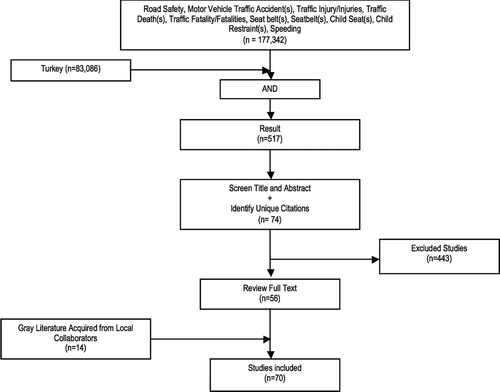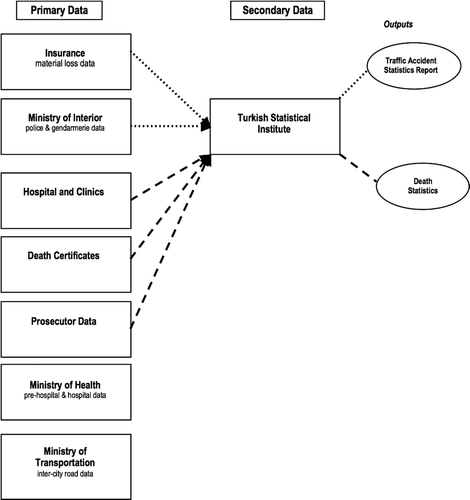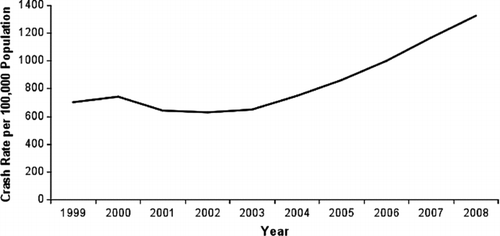Abstract
Objective: Road traffic injuries (RTIs) are one of the leading causes of global deaths, contributing to 1.3 million lives lost each year. Although all regions are affected, low- and middle-income countries share a disproportionate burden. The significance of this public health threat is growing in Turkey, where current estimates show that 2.0 percent of all deaths in the country are due to RTIs. Despite the significance of this growing epidemic, data pertaining to RTIs in Turkey are limited. In order to address the gap in knowledge, this article presents an overview of the epidemiology of RTIs in Turkey through an analysis of available secondary data sets and a comprehensive review of scientifically published studies.
Methods: A literature review was performed during December 2010 using PubMed, Embase, and ISIS Web of Knowledge databases and Google search engines. Peer-reviewed literature pertaining to Turkey and RTIs were selected for screening. Secondary data were also procured with assistance from Turkish colleagues through an exploration of data sources pertaining to RTIs in Turkey.
Results: The literature review yielded a total of 70 studies with publication years ranging from 1988 to 2010. Secondary data sources were procured from the ministries of Health and Interior as well as the Turkish Statistical Institute. These data sources focus primarily on crashes, injuries, and fatalities (crash rate of 1328.5 per 100,000 population; injury rate of 257.9 per 100,000 population; fatality rate of 5.9 per 100,000). Risk factor data surrounding road safety are limited.
Conclusion: The findings reveal the significant burden that RTIs pose on the health of the Turkish population. The introduction of new technologies such as the novel digital recording systems in place to record pre-hospital services and Global Positioning System (GPS) tracking of road traffic crashes by the police have allowed for a more accurate picture of the burden of RTIs in Turkey. There are, however, some considerable gaps and limitations within the data systems. Incorporation of standardized definitions, regular data audits, and timely review of collated data will improve the utility of RTI data and allow it to be used for policy influence.
INTRODUCTION
Injury is one of the leading causes of mortality and disability worldwide, contributing to 5.8 million lives lost each year (World Health Organization [WHO] 2004). This translates to 10 percent of the world's deaths—surpassing, by 32 percent, the number of HIV, malaria, and tuberculosis-related fatalities (WHO 2010). Among all of the causes of injury-related deaths, road traffic injuries (RTIs) are responsible for 23 percent of the lives lost and was the ninth leading contributor to global deaths in 2004 (WHO 2004, 2010). The significance of this public health issue is expected to grow significantly; RTIs are projected to become the fifth leading cause of death by 2030, resulting in an estimated 2.4 million lives lost (WHO 2004).
Although RTIs can affect all regions of the world, the global distribution is biased toward low- and middle-income countries (LMICs) such that they share a disproportionate burden of RTI-related morbidity and mortality (Nantulya and Reich Citation2003; WHO 2004, 2010). Low-income countries witness road traffic fatality rates of 21.5 per 100,000 population compared to that of high-income countries, which have a fatality rate of 10.3 per 100,000 (WHO 2009). In addition to being a grave public health concern, RTIs are tremendously costly for both developed and developing countries. The global cost is estimated to be about US$518 billion (Jacobs et al. Citation2000; WHO 2010).
In 2004, road traffic crashes were ranked as the WHO European Region's (EUR) sixth leading cause of burden of disease contributing to 3.7 million disability-adjusted life years (DALYs) lost, 129,000 deaths, and 2.4 million injuries. Low- and middle-income European countries suffered a heavier burden compared to high-income (HIC) European countries. Of the 129,000 deaths, 91,000 (70.5%) were from the region's LMICs and 38,000 (29.5%) were from EUR's HICs (WHO 2004). Similarly, the average RTI mortality rate was 18.7 per 100,000 population and 7.9 per 100,000 population for the region's LMICs and HICs, respectively (Jacobs et al. Citation2000). Similar to global trends, young people tend to share a greater burden of RTIs. In fact, during 2004, they were the leading cause of death for EUR's 5 to 14 and 15 to 29 age groups and the third leading cause of death for those between 30 and 44 years (Jacobs et al. Citation2000; WHO 2004). Males also experienced a higher risk of RTI-related mortality compared to females, accounting for three fourths of the total deaths (Jacobs et al. Citation2000).
As with other regions, the economic impact of RTIs for EUR is tremendous. Studies have shown that the costs vary from 0.4 to 3.1 percent of the gross domestic product. Unfortunately, many countries currently lack systems that would allow for more accurate measurements of the economic burden (Jacobs et al. Citation2000).
The Republic of Turkey is a middle-income country located within the WHO European Region (World Bank). With an area of 783,562 km2, it is divided into 81 administrative provinces and 923 districts. As of July 2010, the total population of the country was estimated to be over 77 million with a growth rate of 1.3 percent, birth rate of 18.3 births per 1000 population, and death rate of 6.1 per 1,000 population (Central Intelligence Agency). In 2004, the first National Burden of Disease and Cost Effectiveness Study showed that RTIs were an important cause of death contributing to 2.0 percent of all fatalities (2.6% of all male fatalities), 3.8 percent of all years of life lost (YLL; 4.8% for males) and 2.4 percent of all DALYs (3.3% for males). The significance of this public health issue was more pronounced when the disease burden of children and individuals in the most economically productive age group were examined; RTIs were the sixth leading cause of death for children under 15 years and third for those between 15 and 59 years (Ministry of Health of Turkey, Refik Saydam Hygiene Center Presidency School of Public Health).
Unfortunately, data pertaining to the national burden of RTIs in Turkey are scarce, and written reports are not readily accessible to the public. What does exist is limited to small-scale, city-based studies. Though a partially functioning civil registration system has greatly improved over the past 5 to 10 years, major gaps in data collection continue to exist in Turkey, particularly with respect to RTIs. Such incomplete vital registration has necessitated the use of statistical modeling and epidemiological data to estimate mortality and morbidity in Turkey (Akgun et al. Citation2007).
The primary goal of this article is to review the secondary data sources available in Turkey in order to present an overview of the epidemiology of RTIs in Turkey. We identify some of the strengths and weaknesses of datasets pertaining to RTIs in Turkey through a basic strengths, weaknesses, opportunities, and threats (SWOT) framework. A secondary goal is to present the findings of a comprehensive review of scientifically published studies because currently there are no systematic reviews or summary papers published in the scientific literature on the national burden of RTIs in Turkey.
METHODS
A thorough literature review was performed during December 2010 using PubMed, Embase, and ISIS Web of Knowledge databases; Google search engines; and gray literature. The search was conducted using terms such as motor vehicle, road safety, traffic accident, traffic injury, traffic death, traffic fatality, seat belt, child seat, child restraint, OR speeding with Turkey for the years 1988 to the current year. The “related articles” link and the references of reviewed articles were searched for additional references. Initial screening of titles and abstracts excluded case series and non-English-language studies as well as literature that was not accessible electronically. Studies pertaining to Turkey and RTIs were all included. Full texts were then reviewed using the same inclusion and exclusion criteria to obtain relevant data ().
In addition to the literature review, an exploration of data sources pertaining to RTIs in Turkey was carried out. illustrates the governmental organizations in Turkey that are responsible for collecting primary and secondary RTI-related data.
Each data source was reviewed and accessible data were entered into a master database using Microsoft Excel as a platform. From this, each data set was carefully checked for consistencies and spurious results and cross-checked with the original data sets as a means of quality control. We assessed each data source for validity, reliability, timeliness of reporting, and consistency. Absolute numbers of annual crashes, injuries, and fatalities were converted to rates using population statistics for the corresponding year. Simple tables and frequencies for RTIs were run through Stata and disaggregated analysis, where possible, was carried out for gender and age differences. In addition, we applied a standard SWOT framework to our overall assessment of each data source, which is presented in .
Table I Overview of the strengths and weaknesses of select data sources for road traffic injury in Turkey, 2010
RESULTS
Analysis of available secondary data sources revealed that 3 governmental entities—the Turkish Statistical Institute, Ministry of Interior, and Ministry of Health—are responsible for the collection of road traffic injury–related data. We present a description of the main sources used for the purposes of this article, including a review of their strengths and limitations ().
Ministry of Interior
Two departments under the Ministry of Interior collect RTI-related information: the General Directorate of Security (GDS) and the gendarmerie. The Turkish gendarmerie is a branch of the TurkishArmedForces and it is responsible for the maintenance of the public order in areas that fall outside the jurisdiction of police forces (generally in rural areas). As required by law, road traffic crash reports are completed after every crash (TurkStat 2008b). Raw data are then compiled and sent to TurkStat for analysis. Information regarding road traffic crashes, injuries, and fatalities are collected by both entities. The data from the gendarmerie, however, were not readily accessible for purposes of this article because it does not report to TurkStat on a regular basis and therefore most of the presented data are from the traffic police jurisdiction only.
It is important to note that, unlike the annual traffic statistics report, data from the Ministry of Interior are raw data and not presented in summary tables. Unfortunately, this information is generally difficult for the public to access.
Ministry of Health
In 2008, to improve postcrash care in Turkey, a Digital Take Calls and Operation Management System was developed by the Ministry of Health Crisis Center. This 24-h system covers all 81 provinces and tracks emergency vehicles using Global Positioning Systems (GPS). Various indicators are recorded, including the number of emergency calls taken, number of cases, hospital situations, as well as response time. Both national- and provincial-level information are available. These data are limited to emergency call-outs and therefore do not include deaths post-hospital care. Although some risk factor information can be determined by reviewing the type of injuries or medical exams required by road traffic victims, these are not recorded in a consistent manner and have not been utilized for the purposes of this article.
Turkish Statistical Institute
The Turkish Statistical Institute (TurkStat) is a government agency charged with collecting, compiling, and disseminating national statistics. Each year, TurkStat and the GDS prepare an annual traffic accident statistics report from raw police, gendarmerie, and insurance data. The purpose of this publicly available document is to assemble statistics related to road traffic crashes, deaths, injuries, and material loss in the country such that the data can help inform key decision makers and allow for international comparisons (TurkStat 2008b). Currently, road traffic crash reports are completed after every crash and compiled monthly as required by Highway Traffic Law No. 2918. Key variables include crashes, injuries, fatalities, and various risk factors (i.e., age, gender, seat belt use, and speed). Despite the range of variables available, the annual traffic statistics report presents these data in summary tables. Raw data are inaccessible to the public.
Information regarding the extent of injuries and deaths that have occurred during transport to medical care and at the hospital are not included (Bilgic and Karacasu; SweRoad 2001). Only fatalities that occur at the scene are reported—those that occur within the official 30-day post-RTI definition of a road traffic fatality are currently not reported. However, this gap in the data collection process has been identified and TurkStat is currently working with the GDS (Turkish police) to bring their reporting strategies in line with international standards.
Data from the aforementioned secondary sources focused on crashes, injuries, and fatalities. There was limited national data on risk factors surrounding road safety in Turkey. Using the Turkish Statistical Institute's population figures and number of registered motor vehicles, the country's crash, injury, and death rates were calculated and are described below.
Road Traffic Crashes
According to the 2008 traffic accidents statistics report, there were over 71 million individuals residing in Turkey and more than 13 million registered motor vehicles. A total of 950,120 road traffic crashes were reported during this year, of which 898,451 and 51,669 were from the responsibility areas of the traffic police and the gendarmerie, respectively. Using the total population presented in this report, the annual crash rate for 2008 was calculated to be 1328.5 per 100,000 population (), which exceeded the rate of the previous year (1169.6 per 100,000 population) and nearly doubled that of 1999 (702.8 per 100,000 population). Using the number of registered motor vehicles as the denominator, the crash rate per vehicle revealed that the number of crashes grew at approximately the same rate as the number of vehicles: 6005.2 per 100,000 vehicles in 1999 and 6902.2 per 100,000 vehicles in 2008 (TurkStat 2008b).
The road traffic crash rate of drivers in 2008 was 343.2 per 100,000 population for males and 17.8 per 100,000 population for females. Individuals between 25 and 64 years shared the heaviest burden compared to those in the 15 to 24 and 65+ categories (TurkStat 2008b; ). Disaggregating road traffic crashes by regions, the highest road traffic crash rates within the traffic police responsibility area occurred in Istanbul, West Anatolia, Aegean, and East Marmara. Together, West Anatolia and Aegean accounted for 249,624 or about 27 percent of all road traffic crashes (TurkStat 2008b).
Road Traffic Injuries
According to the traffic accident statistics report, in 2008, 184,468 individuals were injured in road traffic crashes, of which 145,163 were in the responsibility area of traffic police and 39,305 were in the responsibility area of the gendarmerie at the time of the crash. This translates to a rate of 257.9 per 100,000 population. As illustrated in , the injury rate decreased to 169.6 per 100,000 population in 2001, steadily increasing to 267.8 per 100,000 population in 2007. This was followed by a slight drop in 2008 (TurkStat 2008b).
Consistent with global and regional trends, males accounted for more of the RTIs than females. The RTI rate for males in the traffic police jurisdiction was 288.9 per 100,000 population, considerably higher than the corresponding female RTI rate of 116.4 per 100,000 population (TurkStat 2008b). Individuals between 25 and 64 years shared a disproportionate burden, with an injury rate of 245 per 100,000 population compared to the under 25 and over 65 groups (). The majority of the victims were passengers (49%), followed by drivers (39%) and pedestrians (12%; TurkStat 2008b).
Road Traffic Deaths
Data from the 2008 traffic accident statistics report showed that the number and rate of traffic fatalities at the scene of the crash have generally decreased (). In 1999, for example, there were 5713 RTI-related deaths in both traffic police and gendarmerie responsibility areas, whereas in 2008 there were 4236. The corresponding road traffic fatality rate per 100,000 population was 8.6 in 1999 and 5.9 in 2008. The majority of fatalities occurred in the Aegean region, suffering 15 percent of the total RTI-related deaths in 2008. The second highest number of fatalities occurred in the Mediterranean region of Turkey (12%), followed by East Marmara (12%), West Black Sea (11%), and West Antolia (9%; TurkStat 2008b).
Figure 3c Annual road traffic fatality rate per 100,000 population (1999– 2008) in Turkey. Source: TurkStat (2008a).
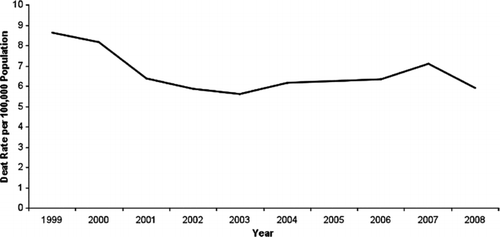
Figure 4a Road traffic crash rate of drivers in 2008 by age and gender (traffic police jurisdiction only). Source: TurkStat (2008b).
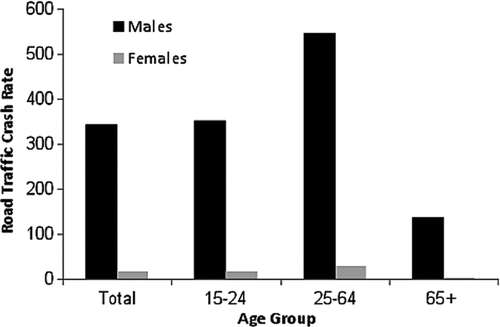
Similar to road traffic crashes and injuries, males accounted for more of the deaths compared to females in 2008. The rates of road traffic deaths per 100,000 population were 6.3 and 1.9, respectively (TurkStat 2008b). When disaggregating road traffic deaths by age group, the majority of the victims were 65 years and above. These individuals experienced a death rate of 6.4 per 100,000 population. The second highest rate of road traffic deaths occurred in the 25 to 64 age range (5.5 per 100,000 population) and the lowest in the 25 and under group (1.9 per 100,000 population; TurkStat 2008b).
Figure 4b Road traffic injury rate per 100,000 population in 2008 by age (traffic police jurisdiction only). Source: TurkStat (2008b).
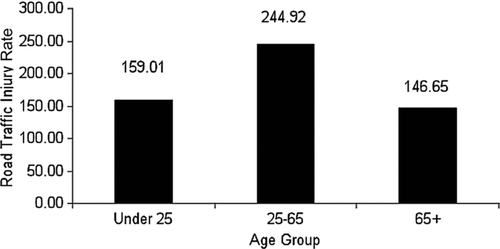
Figure 4c Percentage of road traffic deaths in 2008 by road user type (traffic police jurisdiction only). Source: TurkStat (2008b).
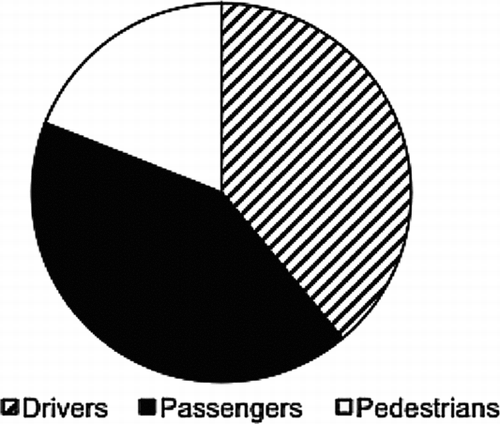
Similar to RTIs, when disaggregating by road user type, the majority of the fatal road traffic crash victims were passengers. This group experienced 1245 lives lost or 42 percent of the total deaths in 2008 within the traffic police jurisdiction only. Drivers and pedestrians accounted for 1149 (39%) and 554 (19%) deaths, respectively (TurkStat 2008b).
The literature review yielded a total of 70 studies with publication years ranging from 1988 to 2010: cost studies (n = 3), hospital-based (n = 21), medicolegal (n = 8), modeling (n = 3), population-based (n = 3), secondary analysis (n = 6), sociobehavioral (n = 20), spatial analysis (n = 4), and others (n = 2; ). Although various study designs exist, the majority were hospital-based or qualitative sociobehavioral studies. Together, the 2 categories accounted for 58.57 percent of the identified literature. Very few studies, on the other hand, took a population-based approach. A full summary of selected studies is presented in .
Table II Summary of selected studies on road traffic injuries in Turkey literature review
Results from the literature review showed that the majority of victims were male, consistent with global and regional trends (Akgungor Citation2007; Alicioglu et al. Citation2008; Aygencel et al. Citation2008; Cekin et al. Citation2005; Demircan et al. Citation2008; Durak et al. Citation2008; Esiyok et al. Citation2005; Fedakar et al. Citation2005; Hilal et al. Citation2010; Yagmur et al. Citation1999). This difference was explored by social and behavioral studies, which found that high perceptual-motor skills were associated with being male and having high masculinity scores, whereas high safety skills were associated with having high femininity scores (Ozkan and Lajunen Citation2006). Similarly, the relationship between high masculinity scores and risky driving such as aggression and committing violations were positively associated (Ozkan and Lajunen Citation2005). Most studies also revealed that vehicle occupants were at higher risk for RTIs and fatalities compared to other road user types (Akgungor Citation2007; Aygencel et al. Citation2008; Donmez and Gokkoca Citation2003; Durak et al. Citation2008). However, risk factors were only examined by a handful of studies, particularly those in the social and behavioral fields (Oksuz and Malhan Citation2005; Ozkan and Lajunen Citation2006; Sevketoglu et al. Citation2009; Simsekoglu Citation2005; Sumer Citation2003).
Overall, the findings suggested that seat belt and child restraint usage were low and the speed of vehicles tended to be above the legal limit. Hospital-based studies, for example, showed that 93.1 to 98.2 percent of injured victims did not wear seat belts (Aygencel et al. Citation2008; Durak et al. Citation2008). Other studies revealed that the proportion of drivers wearing seat belts ranged from 17.1 to 52.1 percent (Oksuz and Malhan Citation2005; Porter et al. Citation2010; Simsekoglu Citation2005; Yildirim and Lajunen Citation2009). In terms of child restraint use, studies have found that only 10 percent of mothers reported the use of this safety device correctly, and 24.5 percent of vehicles with children had child seats (Porter et al. Citation2010; Sevketoglu et al. Citation2009). Moreover, about 97 percent of vehicles examined exceeded the speed limit in a study conducted in Ankara (Yildirim and Lajunen Citation2009). Recommendations revolved around education, enforcement, and engineering.
discussion
This article, for the first time, puts together a systemic review of the literature surrounding RTIs as well as secondary data in order to provide a more accurate description of the burden of RTIs in the Republic of Turkey.
The findings presented in this article highlight the significant burden that RTIs pose on the health of the Turkish population. Though the systematic review revealed that there were a number of studies emanating from Turkey that focused on RTIs, the majority of them were small-scale facility or city-based studies. There is therefore a strong push for academic researchers in Turkey to move forward with population-based and more systematic studies.
Available secondary data revealed the dramatic rise in road traffic crash and injury rates since 1999. Given that studies have demonstrated that economic growth and rate of motorization can lead to significant increases in the number of road traffic injuries, these trends are expected and have important implications for Turkey. Proper interventions are needed in order to prevent the likely increase of RTI over the next few years. The decreasing road traffic fatality trends, particularly in light of increasing crash and injury rates, must be observed with caution. Changes in reporting systems to simplify forms and cut down time spent on paperwork and underreporting (due to the lack of 30-day follow-up of road traffic victims) are just some of the reasons why this apparent decrease in rate may be observed. Recent improvements in postcrash care, vehicle inspections, and roadside auditing could also explain this drop. Clearly, although deaths due to RTIs are tragic and preventable, the greater impact of RTIs is the morbidity and disability that accompanies nonfatal injuries. In addition, the greater impact that crashes are having on the economically productive male age groups is a major cause for concern (Ministry of Health of Turkey, Refik Saydam Hygiene Center Presidency School of Public Health; TurkStat 2008b; WHO 2010). Though cost data from Turkey are limited, in 2003, TurkStat estimated that road traffic crashes cost US$334,024,894—a significant financial burden for Turkey (Esiyok et al. Citation2005).
As Turkey's economy grows, and investments are made both within the health sector and the transport sector, there has been a visible improvement in both the nature and quality of road traffic data (TurkStat 2008a, 2008b). The central reporting of all road traffic data to TurkStat is, in many respects, a valuable model enabling intersectoral data to be brought together and presented in the public domain. The annual 2008 traffic accident statistics report formed a strong basis for this analysis and, though limitations with the various available data sets, including time lag and accessibility, prevented a thorough comparison between these sources, we were able to secure some additional current figures from these additional sources to incorporate into the article. The TurkStat model is valuable because it provides a good opportunity for data quality control, consistency checks, and a platform for intersectoral collaboration.
Unfortunately, considerable gaps and limitations within the data systems in Turkey need to be addressed in order to provide a more accurate estimation of the burden of RTIs (). Using the WHO (2004) injury surveillance guidelines, current data sources do not capture the core data set required for the development of effective prevention measures. This includes demographic information, injury event factors, injury-related disability, medical care and treatment, post-injury impact, and injury-related deaths. Death statistics, for example, need to extend beyond the provincial and district centers. The GDS and Ministry of Health should include 30-day follow-up for RTI victims, risk factors, and a more comprehensive documentation of postcrash outcomes. Similarly, misreporting of road traffic crashes and injuries by the GDS will also need to be rectified. As these raw data from GDS and Ministry of Health are fed to TurkStat, improvements in these primary data sources will help enhance the quality of reports, including the annual traffic accident statistics.
Collaborative efforts between the ministries of Health and Transport in Turkey could result in an appraisal of the information services surrounding RTIs. Frameworks such as the Performance of Routine Information System Management (PRISM; Aqil et al. 2009) could guide the development of interventions to strengthen data systems. The establishment of routine injury surveillance within hospitals (to include disability, cost, and injury severity data), standardization of definitions revolving around RTIs with international guidelines, and increased emphasis on the collection of risk factor data will substantially enhance the quality of RTI data in Turkey. With this commitment to improving data systems in place, it is clear that the situation with regard to road safety in Turkey will be ripe for investments.
The burden of RTIs in Turkey is high for the European region; however, the current approach to data collection through the collaborative model of the Turkish Statistical Institute is a great opportunity for enhancing quality and promoting harmony with international standards. Incorporation of standardized definitions, regular data audits, and timely review of collated data will improve the utility of RTI data and allow it to be used for policy influence. This is important for promoting an evidence-based road safety portfolio across all actors in Turkey.
ACKNOWLEDGMENTS
This work was conducted as part of the Road Safety in 10 Countries project funded by the Bloomberg Philanthropies. The authors would like to thank Dr. Adnan Hyder for his support and guidance in analyzing the data and preparing the manuscript.
REFERENCES
- Akgun , S , Rao , C Yardim , N . 2007 . Estimating mortality and causes of death in Turkey: methods, results and policy implications . Eur J Public Health. , 17 : 593 – 599 .
- Akgungor , A P . 2007 . Road traffic accidents and safety programme in Turkey . Int J Inj Contr Saf Promot. , 14 : 119 – 121 .
- Aksoy , E , Ãœnl , E and Åžensz , Ã . 2002 . A restrospective study on epidemiology and treatment of maxillofacial fractures . Journal of Craniofacial Surgery. , 13 ( 6 ) : 772 – 775 .
- Alicioglu , B , Yalniz , E , Eskin , D and Yilmaz , B . 2008 . Injuries associated with motorcycle accidents [Turkish] . Acta Orthop Traumatol Turc. , 42 : 106 – 111 .
- Aqil , A , Lippeveld , T and Hozumi , D . 2009 . PRISM framework: a paradigm shift for designing, strengthening and evaluating routine health information systems . Health Policy Plan. , 24 : 217 – 228 .
- Aras , M D , Kaya , A , Ãtakci , A and Gakkaya , K O . 2004 . Functional outcome following traumatic brain injury: The Turkish experience . International Journal of Rehabilitation Research. , 27 ( 4 ) : 257 – 260 .
- Asirdizer , M , Yavuz , M S , Buken , E , Daglar , S and Uzun , I . 2004 . Medicolegal evaluation of vascular injuries of limbs in Turkey . Journal of Clinical Forensic Medicine. , 11 ( 2 ) : 59 – 64 .
- Atilgan , S , Erol , B , Yaman , F , Yilmaz , N and Ucan , M C . 2010 . Mandibular fractures: A comparative analysis between young and adult patients in the southeast region of Turkey . Journal of Applied Oral Science , 18 ( 1 ) : 17 – 22 .
- Aygencel , G , Karamercan , M , Ergin , M and Telatar , G . 2008 . Review of traffic accident cases presenting to an adult emergency service in Turkey . J Forensic Leg Med. , 15 : 1 – 6 .
- Bilgic , S and Karacasu , M . 2010 . Uncertainty in the number of traffic accident fatalities in Turkey . Available at: http://www.iasi.cnr.it/ewgt/13conference/36_bilgic.pdf. Accessed September 19
- Birgen , N , Akif Inanici , M and Aliustaog Lu , S . 1999 . The forensic evaluation of dental injuries in Istanbul, Turkey . Forensic Science International. , 106 ( 1 ) : 37 – 43 .
- Caglayan , C , Hamzaoglu , O , Yavuz , C I and Yüksel , S . 2010 . Traffic accidents resulting in death and injury on an international road passing through a city in Kocaeli, Turkey . Archives of Environmental and Occupational Health , 65 ( 2 ) : 59 – 64 .
- Cekin , N , Hilal , A , Gulmen , M K , Kar , H , Aslan , M and Ozdemir , M H . 2005 . Medicolegal childhood deaths in Adana, Turkey . Tohoku J Exp Med. , 206 : 73 – 80 .
- Central Intelligence Agency . 2011 . The World Factbook: Turkey Available at: https://www.cia.gov/library/publications/the-world-factbook/geos/tu.html. Accessed January 3
- Demircan , A , Keles , A Gurbuz , N . 2008 . Forensic emergency medicine—six year experience of 13823 case in a university emergency department . Turk J Med Sci. , 38 : 567 – 575 .
- Demirhan , R , Onan , B , Oz , K and Halezeroglu , S . Sep 2009 . Comprehensive analysis of 4205 patients with chest trauma: a 10-year experience . Interact Cardiovasc Thorac Surg. , 9 ( 3 ) : 450 – 453 .
- Donmez , L and Gokkoca , Z . 2003 . Accident profile of older people in Antalya City Center, Turkey . Arch Gerontol Geriatr. , 37 ( 2 ) : 99 – 108 .
- Durak , D , Fedakar , R , Turkmen , N , Akgoz , S and Baduroglu , E . 2008 . Road traffic collisions in Bursa, Turkey, during 2003, 2004 and 2005 . Injury. , 39 : 547 – 553 .
- Erhan , B , Ulu , M O , Gunduz , B and Tanriverdi , T . 2005 . Pediatric spine and spinal cord injury in Istanbul: A retrospective analysis of 106 patients . Neurosurgery Quarterly. , 15 ( 1 ) : 21 – 24 .
- Ergor , O A , Demiral , Y and Piyal , Y B . 2003 . A significant outcome of work life: Occupational accidents in a developing country, Turkey . Journal of Occupational Health. , 45 ( 1 ) : 74 – 80 .
- Erol , B , Tanrikulu , R and Gorgun , B . 2004 . Maxillofacial fractures. Analysis of demographic distribution and treatment in 2901 patients (25-year experience) . Journal of Cranio-Maxillofacial Surgery. , 32 ( 5 ) : 308 – 313 .
- Erturer , E , Tezer , M , Ozturk , I and Kuzgun , U . 2005 . Evaluation of vertebral fractures and associated injuries in adults . Acta orthopaedica et traumatologica turcica. , 39 ( 5 ) : 387 – 390 .
- Esiyok , B , Korkusuz , I , Canturk , G , Alkan , H A , Karaman , A G and Hanci , I H . 2005 . Road traffic accidents and disability: a cross-section study from Turkey . Disabil Rehabil. , 27 : 1333 – 1338 .
- Fedakar , R , Turkmen , N , Durak , D and Gundogmus , U N . 2005 . Fatal traumatic heart wounds: review of 160 autopsy cases . Isr Med Assoc J. , 7 ( 8 ) : 498 – 501 .
- Gur , A , Kemaloglu , M S Cevik , R . Mar 2005 . Characteristics of traumatic spinal cord injuries in south-eastern Anatolia, Turkey: a comparative approach to 10 years’ experience . Int J Rehabil Res , 28 ( 1 ) : 57 – 62 .
- Gurses , D , Sarioglu-Buke , A , Baskan , M and Kilic , I . Dec 2003 . Cost factors in pediatric trauma . Can J Surg. , 46 ( 6 ) : 441 – 445 .
- Guven , O . Apr 1988 . A comparative study on maxillofacial fractures in central and eastern Anatolia. A retrospective study . J Craniomaxillofac Surg. , 16 ( 3 ) : 126 – 129 .
- Hilal , A , Akcan , R , Eren , A , Turhan , A and Arslan , M . 2010 . Forensic geriatric deaths in Adana, Turkey . Arch Gerontol Geriatr. , 50 ( 3 ) : e9 – e12 .
- Jacobs , G , Aeron-Thomas , A and Astrop , A . 2000 . Estimating Global Road Fatalities , Crowthorne , England : Transport Research Laboratory .
- Karacan , I , Koyuncu , H Pekel , Ã . 2000 . Traumatic spinal cord injuries in Turkey: A nation-wide epidemiological study . Spinal Cord. , 38 ( 11 ) : 697 – 701 .
- Karamehmetoglu , S S , Nas , K Karacan , I . 1997 . Traumatic spinal cord injuries in Southeast Turkey: An epidemiological study . Spinal Cord. , 35 ( 8 ) : 531 – 533 .
- Ministry of Health of Turkey, Refik Saydam Hygiene Center Presidency School of Public Health . National Burden of Disease and Cost-Effectiveness Project: Burden of Disease Final Report 2004 , Available at: http://www.tusak.saglik.gov.tr/pdf/nbd/raporlar/burdenofdiseaseENG.pdf. Accessed January 3, 2011
- Naci , H and Baker , T D . Mar 2008 . Productivity losses from road traffic deaths in Turkey . International Journal of Injury Control and Safety Promotion. , 15 ( 1 ) : 19 – 24 .
- Nantulya , V and Reich , M . 2003 . Equity dimensions of road traffic injuries in low- and middle-income countries . Inj Contr Saf Promot. , 10 : 13 – 20 .
- Oksuz , E and Malhan , S . 2005 . Socioeconomic factors and health risk behaviors among university students in Turkey: questionnaire study . Croat Med J. , 46 : 66 – 73 .
- Ozkan , T and Lajunen , T . 2005 . Why are there sex differences in risky driving? The relationship between sex and gender-role on aggressive driving, traffic offences, and accident involvement among young Turkish drivers . Aggress Behav. , 31 : 547 – 558 .
- Ozkan , T and Lajunen , T . 2006 . What causes the differences in driving between young men and women? The effects of gender roles and sex on young drivers’ driving behaviour and self-assessment of skills . Transp Res Part F Traffic Psychol Behav. , 9 : 269 – 277 .
- Ozkaya , O , Turgut , G , Kayali , M U , Ugurlu , K , Kuran , I and Bas , L . 2009 . A retrospective study on the epidemiology and treatment of maxillofacial fractures . Ulusal Travma ve Acil Cerrahi Dergisi. , 15 ( 3 ) : 262 – 266 .
- Porter , B , Lajunen , T , Ozkan , T and Will , K . 2010 . A behavioral observation study of Turkish drivers’ and children's safety belt use . Procedia Soc Behav Sci. , 5 : 1607 – 1609 .
- Rasanen , M , Lajunen , T , Alticafarbay , F and Aydin , C . 2007 . Pedestrian self-reports of factors influencing the use of pedestrian bridges . Accident; analysis and prevention. , 39 ( 5 ) : 969 – 973 .
- Sevketoglu , E , Hatipoglu , S , Esin , G and Oztora , S . 2009 . Knowledge and attitude of Turkish parents regarding car safety seats for children . Ulus Travma Acil Cerrahi Derg. , 15 : 482 – 486 .
- Simsek , S , Simsek , B , Abubaker , A O and Laskin , D M . 2007 . A comparative study of mandibular fractures in the United States and Turkey . International Journal of Oral and Maxillofacial Surgery. , 36 ( 5 ) : 395 – 397 .
- Simsekoglu , O. 2005 . Coorelates of Seat Belt Use Among Turkish Front Seat Occupants , Ankara , , Turkey : Department of Psychology, Middle East Technical University .
- Soylu , M , Demircan , N , Yalaz , M and Isiguzel , I . 1998 . Etiology of pediatric perforating eye injuries in Southern Turkey . Ophthalmic Epidemiology. , 5 ( 1 ) : 7 – 12 .
- Cherry , R A Lehman , E . Aug 2008 . Comparison of trauma mortality between two hospitals in Turkey to one trauma center in the US . Eur J Emerg Med. , 15 ( 4 ) : 209 – 213 . Squyer Et
- Sumer , N. 2003 . Personality and behavioral predictors of traffic accidents: testing a contextual mediated model . Accid Anal Prev. , 35 : 949 – 964 .
- Sut , N and Memis , D . Mar 2008 . Intensive care cost and survival analyses of traumatic brain injury . Ulus Travma Acil Cerrahi Derg. , 16 ( 2 ) : 149 – 154 .
- SweRoad . 2001 . Traffic Safety Project: Methods and Values for Appraisal of Traffic Safety Improvements , Solna , , Sweden : SweRoad .
- 2004 . Turkish Ministry of Health, National burden of disease and cost-effectiveness study report Ankara
- Turkmen , C and Yormaz , E . 2006 . Incidental detection of multiple abdominopelvic splenosis sites during Tc-99m HMPAO-labeled leukocyte scintigraphy . Clin Nucl Med. , 31 ( 9 ) : 572 – 574 .
- TurkStat . 2008a . Death Statistics , Ankara : Turkish Statistical Institute .
- TurkStat . 2008b . Traffic Accident Statistics Report , Ankara : Turkish Statistical Institute .
- Uzun , N , Tanriverdi , T Savrun , F K . 2006 . Traumatic peripheral nerve injuries: Demographic and electrophysiologic findings of 802 patients from a developing country . Journal of Clinical Neuromuscular Disease. , 7 ( 3 ) : 97 – 103 .
- Wallen Warner , H , Ozkan , T and Lajunen , T . Jul 2009 . Cross-cultural differences in drivers’ speed choice . Accid Anal Prev. , 41 ( 4 ) : 816 – 819 .
- World Bank . 2010 . Country and Lending Groups http://data.worldbank.org/about/country-classifications/country-and-lending-groups#Upper_middle_income. Accessed September 19
- World Health Organization . 2004 . The Global Burden of Disease: 2004 Update , Geneva , , Switzerland : World Health Organization .
- World Health Organization . 2009 . Global Status Report on Road Safety , Geneva , , Switzerland : World Health Organization .
- World Health Organization . 2010 . Injuries and Violences the Facts , Geneva , , Switzerland : World Health Organization .
- Yagmur , Y , Kiraz , M and Kara , I . 1999 . Looking at trauma and deaths: Diyarbakir City in Turkey . Injury. , 30 ( 2 ) : 111 – 114 .
- Yasak , Y and Durak Batigan , A . 2010 . The role of psychological self-report scales in selection and evaluation of drivers . Anadolu Psikiyatri Dergisi , 11 ( 3 ) : 235 – 241 .
- Yetiser , S , Hidir , Y , Birkent , H , Satar , B and Durmaz , A . Jan-Feb 2008 . Traumatic ossicular dislocations: etiology and management . Am J Otolaryngol. , 29 ( 1 ) : 31 – 36 .
- Yildirim , Z and Lajunen , T . 2009 . Risky Driving during Ramadan: An Observational StudyAnkara . Middle East Technical University , : 1 – 9 .
- Yilmaz , V and Celik , H E . 2004 . A model for risky driving attitudes in turkey . Social Behavior and Personality. , 32 ( 8 ) : 791 – 796 .
